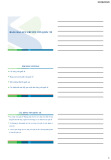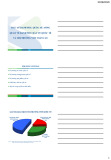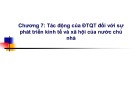
20/08/2020
1
ĐẦU TƯ TRỰC TIẾP NƯỚC NGOÀI:
DỰ ÁN ĐẦU TƯ TRỰC TIẾP NƯỚC
NGOÀI VÀ GIÁ TRỊ KỲ VỌNG
NỘI DUNG CHƯƠNG
Duy trì và di chuyển lợi thế cạnh tranh
Yếu tố quyết định lợi thế cạnh tranh quốc gia
Mô hình OLI
Lựa chọn quốc gia đầu tư
Các hình thức đầu tư ở nước ngoài
Rủi ro hoạt động đầu tư
Duy trì và di chuyển lợi thế cạnh tranh
Trong quyết định đầu tư ở nước ngoài, các doanh nghiệp quốc tế phải xác
định liệu có thể duy trì lợi thế cạnh tranh bền vững giúp công ty có thể cạnh
tranh hiệu quả tại thị trường nội địa với các đối thủ hiện tại.
Lợi thế của việc đầu tư nước ngoài phải đủ đề bù đắp cho những rủi ro tiềm
tàng của hoạt động đầu tư trực tiếp ở nước ngoài như tủi ro tỷ giá, rủi ro
chính trị…cũng như các chi phí gia tăng khác.
Các doanh nghiệp quốc tế có những lợi thế nhất định khi đầu tư trực tiếp
nước ngoài bao gồm:Lợi thế nhờ quy mô, kỹ năng quản trị doanh nghiệp và
tiếp thị, công nghệ, khả năng tài chính, sản phẩm khác biệt, năng lực cạnh
tranh tại thị trường nội địa….

20/08/2020
2
Duy trì và di chuyển lợi thế cạnh tranh
Lợi thế nhờ quy mô:
Lợi thế nhờ quy mô có được nhờ quy mô lớn bao gồm các hoạt động quốc tế và
nội địa của doanh nghiệp quốc tế
Quy mô lớn mang lại các lợi thế trong hoạt động sản xuất, tiếp thị sản phẩm,
R&D, vận chuyển, bán hàng…
Kỹ năng quản trị doanh nghiệp và tiếp thị:
Bao gồm các kỹ năng quản trị các tổ chức quy mô lớn về nguồn nhân lực, vốn
và công nghệ.
Cũng bao gồm kiến thức về các kỹ thuật phân tích hiện đại và ứng dụng của
chúng trong các lĩnh vực của các doanh nghiệp quốc tế
Duy trì và di chuyển lợi thế cạnh tranh
Công nghệ:
Các doanh nghiệp quốc tế có lợi thế nhờ công nghệ hiện đại và
chuyên biệt trong từng ngành nghề, lĩnh vực sản xuất…
Sức mạnh tài chính:
Khả năng tiếp cận các nguồn vốn quốc tế, duy trì cơ cấu vốn quốc
tế và tính sẵn có của vốn
Đây là một yếu tố cạnh tranh quan trọng cho phép các doanh
nghiệp quốc tế tài trợ vốn FDI và các hoạt động khác ở nước ngoài
Duy trì và di chuyển lợi thế cạnh tranh
Sản phẩm khác biệt:
Các doanh nghiệp quốc tế tạo ra lợi thế chuyên biệt bằng cách sản xuất
và tiếp thị phân biệt các dòng sản phẩm
Những sản phẩm này có nguồn gốc từ kết quả R&D hoặc tiếp thị để đạt
được nhận diện thương hiệu của doanh nghiệp quốc tế.
Năng lực cạnh tranh tại thị trường nội địa :
Một thị trường cạnh tranh mạnh mẽ sẽ giúp các doanh nghiệp quốc tế có
lợi thế cạnh tranh hơn các doanh nghiệp hoạt động thuần túy nội địa.
Hiện tượng này được gọi là "lợi thế cạnh tranh của các quốc gia" và có
bốn thành phần như trong hình sau.

20/08/2020
3
Yếu tố quyết định lợi thế cạnh tranh quốc gia: Porter’s Diamond
Mô hình OLI
Mô hình OLI giải thích lý do tại sao các doanh nghiệp quốc tế chọn FDI
hơn là chọn các hình thức đầu tư khác.
"O" yếu tố về chủ sở hữu (lợi thế cạnh tranh trong thị trường trong nước
mà các doanh nghiệp quốc tế có thể được chuyển ra nước ngoài)
"L" yếu tố về vị trí đầu tư (đặc điểm cụ thể của quốc gia nhận đầu tư cho
phép các doanh nghiệp quốc tế khai thác lợi thế cạnh tranh)
“I" yếu tố về nội bộ hóa (duy trì vị thế cạnh tranh của doanh nghiệp quốc
tế dựa trên việc kiểm soát toàn bộ chuỗi giá trị của doanh nghiệp và lợi
thế nhờ hoạt động toàn cầu)
Mô hình OLI và chiến lược tài chính
Chiến lược tài chính chủ động bao gồm:
Chiến lược để đạt được lợi thế từ chi phí toàn cầu thấp hơn
Tính sẵn có lớn hơn của vốn
Tài trợ cho các công ty con hoặc chiến lược về thuế để nâng cao dòng
tiền cho công ty mẹ
Giảm chi phíhoạt động và các rủi ro giao dịch thông qua FDI
Chiến lược tài chính bị động phụ thuộc vào sự không hoàn hảo của thị
trường.

20/08/2020
4
Mô hình OLI và các yếu tố tài chính chuyên biệt
Lựa chọn quốc gia đầu tư
Quyết định về quốc gia để đầu tư bị ảnh hưởng bởi các yếu tố hành vi.
Theo lý thuyết, doanh nghiệp quốc tế cần xác định lợi thế cạnh tranh
của mình, và sau đó tìm kiếm trên toàn thế giới cho sự không hoàn hảo
của thị trường và lợi thế so sánh cho đến khi tìm thấy quốc gia đem lại
lợi thế cạnh tranh lớn, đủ để tạo ra một lợi nhuận điều chỉnh rủi ro trên
mức kỳ vọng tối thiểu của doanh nghiệp.
Trong thực tế, các doanh nghiệp đã được quan sát để theo một mô hình
tìm kiếm tuần tự như mô tả trong lý thuyết về hành vi của công ty.
Trình tự FDI: Sự hiện diện đầu tư nước ngoài

20/08/2020
5
Các hình thức đầu tư ở nước ngoài
Xuất khẩu so với sản xuất ở nước ngoài:
Các doanh nghiệp xuất khẩu có lợi thế so với việc sản xuất ở nước
ngoài là chưa đối mặt với các rủi ro đặc thù của việc hiện diện đầu
tư ở nước ngoài như tỷ giá, chính trị, quốc gia….
Số tiền đầu tư ban đầu là thấp nhất so với các hình thức đầu tư ở
nước ngoài khác
Nhược điểm lớn nhất của hình thức xuất khẩu là để mất thị trường
vào những đối thủ cạnh tranh trực tiếp và các sản phẩm ăn theo
Các hình thức đầu tư ở nước ngoài
Cấp phép và nhượng quyền thương mại so với kiểm soát tài sản ở nước ngoài:
Cấp phép và nhượng quyền thương mại là hình thức phổ biến cho các doanh
nghiệp quốc tế đạt được lợi nhuận từ thị trường nước ngoài mà không cần đầu
tư số vốn lớn.
Tuy nhiên, có những nhược điểm bao gồm:lệ phí từ cấp phép và nhượng
quyền thương mại là thấp hơn so với lợi nhuận từ FDI, khả năng kiểm soát
chất lượng sản phẩm bị hạn chế, có thể thiết lập them các đối thủ cạnh tranh,
việc cải tiến công nghệ của doanh nghiệp được cấp phép và nhượng quyền
thương mại sau đó có thể thâm nhập vào chính thị trường nội địa của các
doanh nghiệp quốc tế, khả năng mất cơ hội đầu tư trực tiếp nước ngoài sau đó,
rủi ro mà công nghệ sẽ bị đánh cắp, chi phí đại diện cao
Các hình thức đầu tư ở nước ngoài
Hợp đồng quản lý tương tự như cấp phép và nhượng quyền thương
mại,các doanh nghiệp quốc tế tạo được dòng tiền từ thị trường nước
ngoài mà không cần đầu tư ra nước ngoài quan trọng hoặc trực tiếp
hiện diện.
Hợp đồng quản lý làm giảm bớt rủi ro chính trị vì sự rời bỏ thị trường
của các doanh nghiệp quốc tế dễ dàng.
Các công ty tư vấn và kỹ thuật quốc tế thường thực hiện hoạt động
kinh doanh quốc tế bằng các hợp đồng quản lý.







![Bài giảng Đầu tư và tài trợ quốc tế [mới nhất]](https://cdn.tailieu.vn/images/document/thumbnail/2025/20250414/trantrongkim2025/135x160/2889753_9121.jpg)















![Bài giảng Đầu tư tài chính: Chuyên đề 2 - TS. Hoàng Thị Bích Hà [Mới nhất]](https://cdn.tailieu.vn/images/document/thumbnail/2025/20251224/kimphuong1001/135x160/31861766558755.jpg)


